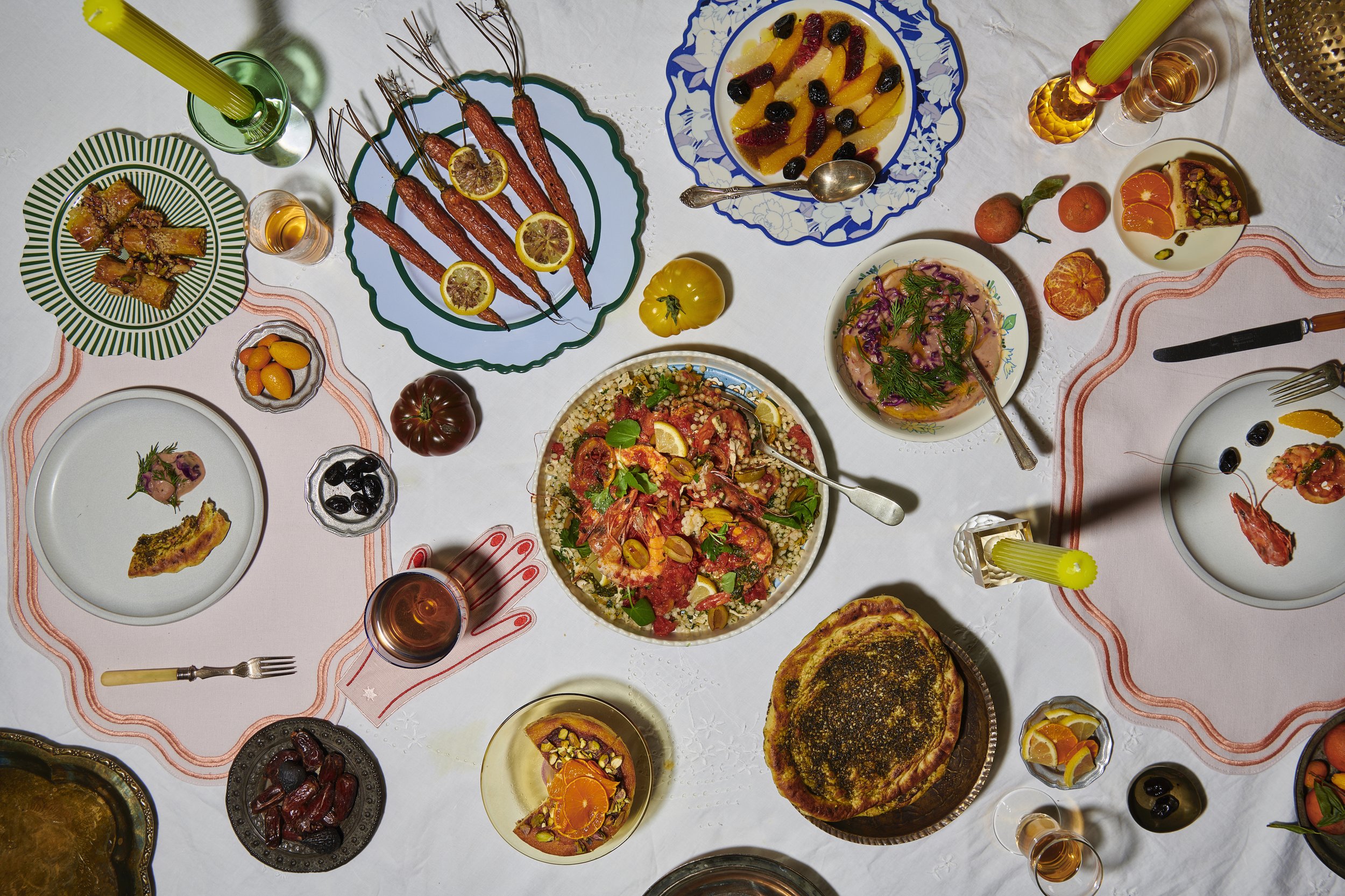Our Moroccan-Inspired Apèro Hour
Moroccan salads are similar to Italian antipasti; they’re served at the beginning of meals to excite the palate and don’t necessarily mean a plate of greens dressed with a vinaigrette. These salads can be made of either fresh or dried vegetables, fish, or cooked meats and are full of contrasting flavors and textures. The dishes can be raw, spiced, sweet, pickled, stewed, braised, or grilled.
When using vegetables in the salads, Moroccans rely on seasonality. Around Fes and the coastal areas of Morocco the agriculture is bountiful and the gardens are lush so vegetables salads are prepared. In the south where produce was once scarce, dates, milk, and a biscuit-like bread served with honey and fermented butter traditionally welcomed one at the table.
A spread of four salad dishes is typical when eating at a Moroccan home; and in many restaurants, you might be served up to a dozen small plates. The dishes are usually on the table as guests sit down, and might be left on the table throughout the entire meal or are sometimes removed when the entrees are ready.
We interpreted this opening course with multiple salads as a Moroccan apèro hour. It’s our favorite part — serving and experiencing — a long, drawn out dinner where conversation slowly builds. The apèro hour is an ice breaker, if you will, designed to help everyone settle into the evening. This could mean the tagine is still stewing, the chicken might still be roasting or the meat is resting — or maybe you just want that extra long cocktail hour (as a person who eats late, I’m not always ready to immediately sit down to dinner when guests arrive).
It also doesn’t necessarily mean one needs to be seated at the table quite yet, you can have a standing apèro hour with a spread of snacks set on the kitchen island, keeping the host company while they finish any final touches. I view it as having a little “borrowed-time” when hosting. Because there’s a spread, your guests feel taken care of and dinner doesn’t need to be rushed to the table.
While serving three or four salads or dishes before dinner can add quite a bit of extra prep time to your dinner party, many of these Moroccan salads can be made in advance — and actually get better the longer they sit. Try the Goat Cheese & Honey Cigars which can be par-baked and frozen, then pulled out and baked right before guests arrive; or the Marinated Citrus Salad that gets more flavorful as it sits; or this bonus recipe below for Eggplant Zaalouk, although we might consider this one to be a dip (that’s my kind of salad).
P.S. We’re definitely not claiming to be experts on Moroccan food, culture, or tradition. We’re exploring it just as much as you are. If you’re in the Minneapolis/St. Paul area, go to the Midtown Global Market to eat at Moroccan Flavors, a restaurant owned by Hassan Ziadi.
Eggplant Zaalouk
serves 4
shopping list —
2 medium or 1 large eggplant
3 ripe tomatoes, peeled, chopped, and seeds removed
4 cloves garlic, minced
1 tsp ground cumin
2 tsp paprika
1/4 tsp cayenne pepper
salt to taste
1/3 cup olive oil
1 tsp white vinegar or lemon juice
2 tbsp minced cilantro
2 tbsp minced parsley
equipment —
fork or toothpick
sheet tray line with foil
colander
mixing bowl
non-stick pan
steps —
Pierce each eggplant in a few places with a toothpick or fork. Preheat the broiler to low and set the top rack in middle of the oven. Halve each eggplant lengthwise, place cut side down on a foil-lined sheet tray, and broil until blackened and tender, about 20 minutes. Peel immediately when still warm. Allow to drain in a colander until cool. Squeeze gently to remove any bitter juices.
*Alternatively, you can char the eggplants over coals when it’s grilling season!
Heat 3 tbsp olive oil in non-stick pan over medium heat. Add the garlic, cumin, paprika, and cayenne pepper. Saute for 2-3 minutes and then add tomatoes, sugar, and salt. Cook, stirring occasionally, for about 20 minutes.
Crush the eggplant with a fork and add it to the skillet. Stir in the cilantro and parsley, and continue cooking, stirring often, until thick — about 10-15 minutes. Transfer to a bowl and season with lemon juice and salt to taste. Let cool. Refrigerate ideally overnight.
Before serving, fold in the remaining olive oil. Re-season if needed.

